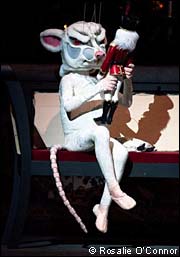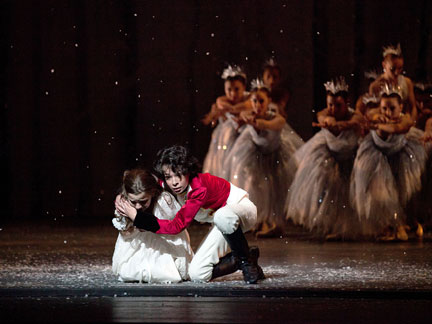Yes, ridiculous: now that all the nuts are cracked, I get around to posting these.
It was an especially bountiful Nutcracker season here in New York. Besides the glorious perennial, New York City Ballet’s Balanchine production, Ratmansky mounted his very own version for ABT and Mark Morris’s Hard Nut made a rare (too rare, I say) East Coast appearance.
The Ratmansky excited me so much, I hardly knew where to begin. But I began. Below, a chunk of that review. We are lucky–the ABT production will return to BAM next year, when I hope to get to some thoughts that didn’t make it into this first review (like, for example, more about the choreography, which is delectable, and mainly ensemble work: a very deliberate choice, I think).
For Alexei Ratmansky’s latest revelation, a deep and vivid Nutcracker, the former Bolshoi director and current American Ballet Theatre resident choreographer has absorbed influences as various as Balanchine and Mark Morris. Yet in spirit, story and choreography this two-hour drama is indelibly his own: at once goofy and wise, theatrical and musical, casually gestural and mindbogglingly virtuosic, entertaining and moving. Despite its setting in the cosily domestic Biedermeier era of 19th-century Germany, it is also thoroughly contemporary.Like many Nutcrackers, this one offers a child’s-eye view of life’s wonders and terrors. Like many, it reveals our heroine, Clara, stretching towards young adulthood. But its vision of this blooming is all its own – with the fantastical learning to live in peace with the real, the private with the public, the gleefully childlike with the soberly adult, in an intricate psychological design.
The ballet begins in the messy kitchen of the Stahlbaum house, where secrets are spilled and appetites cooked up. Two sassy maids show off the mincing steps they have gleaned from past parties, just as Clara (a persuasive Catherine Hurlin) will learn from the current one. She and her little brother Fritz are salivating over more immediate and childish pleasures, a tray of freshly baked sweets.
Beneath the worktable, a scene-stealing Little Mouse (delightful Justin Souriau-Levine) gnaws on a massive wedge of cheese in a foreshadowing of the larger, more ravenous vermin to come. The Stahlbaum parents steal a swoony kiss. And after everyone has left for the festivities in the living room, Drosselmeyer (Victor Barbee) enters. His wavy locks signal his Romantic standing in this stalwartly bourgeois milieu; so does his latest creation, the bewitched nutcracker doll, which he will bestow on his favourite godchild along with his invisible gift for fantasy.
The Little Mouse (Justin Souriau-Levine) eying his nemesis. Photo by Rosalie O’Connor for ABT.
Ratmansky sounds the note of romance lightly but consistently: the life-sized dolls with which Drosselmeyer entertains the guests come in male-female pairs, and Clara’s girlfriends pant after the imperious wizard as if he were Elvis. So the winter wonderland music that swells in the wake of the battle between the mice and the toy soldiers anticipates not only the coming snow but also Clara’s feelings for the boy inside the Nutcracker shell whom she has saved (a sweetly shy Tyler Maloney).
Yet the choreographer does not make the Soviet mistake of having Clara instantly shed her child heart and fall lustily in love, at which point Candyland would only bore her. Rather, she and the boy mix awkward hugs with snowball fights.
The snow grows dangerous. Photo by Erin Baiano.
When their imagined older selves appear, the children waltz alongside them for as long as they can keep up. (On opening night, a buoyant and slippery Gillian Murphy and an impetuous David Hallberg did the honours as mature princess and prince; at the Friday matinee, it was a coltish Paloma Herrera with a somewhat shell-shocked Cory Stearns. [Ed. note, just promoted to principal–and yet he is hardly used to being a soloist!])
The Sugar Plum pas de deux, the apotheosis of this dream romance, sustains a goofy delirium beside a more traditional nobility. Likewise, Ratmansky injects a quartet of begoggled bumblebee men into the unfolding mass of waltzing flowers, models the Russian dancers after the Three Stooges, and has Mother Ginger’s tiny charges do a squat and sassy chain-gang dance with waggling heads and slapping feet (it perfectly becomes them).
He has a special gift for idiosyncrasy, which he celebrates with every low-key, handmade moment and every child – the production abounds in them – allowed his or her fervour and force. (British set and costume designer Richard Hudson brilliantly complements this vision with individually detailed costumes in outlandishly gorgeous hues.)
For the coup de theatre of the Ratmansky Nutcracker–the dangerous snow scene, with hapless Siren Flakes–click here.
To all those Brooklyn parents of youngish children, this is a great Nutcracker for kids–and not just because there are a lot of them. As I suggest above, Ratmansky allows his little charges a buoyant ferocity and goofiness that are the vernacular of children. At the one matinee I got to, a Russian mother behind me who had come down from Ithaca was fretting at intermission over whether she had brought her 5-year-old son to the right Nutcracker–should she have done the Balanchine instead? But at the final bows, she reported it was the first Nutcracker (of four) her son had stayed awake for in the second act. Of course, this may only be because he is now a year older…
The chief new pleasure of this year’s Hard Nut
was Morris’s debut as the Homer-Simpson-like Dad Stahlbaum: myopically trying to fulfill his duty as head of the clan when he’s most definitely its tail. Everyone was fantastic, in fact–that’s one thing you can count on in a Morris production. I didn’t have the space here to write much about the dancers, unfortunately.
More than most American versions of The Nutcracker, Mark Morris’s campy, thoroughly hopeful take is a love story – about how random acts of horniness in a newly liberated yet still ticky-tacky America might inspire a child to something genuine when she grows up (quickly, of course).
Any decent Nutcracker deftly establishes the real-world setting from which its nightmares and dreams will spring. Morris’s 20-year-old tale takes place wherever the defanged Nutcrackers that this Nut fondly despises might tinkle: elevators, supermarkets or at the Stahlbaum Christmas party circa 1970. The guests, in pompadours and polyester disco duds, are already washed up. It makes you want to giggle and moan. The partiers bump and grind and perform other mildly naughty moves on one another – Morris, like Balanchine, has one intrigue tumble after another – but, as Tchaikovsky’s light music (too light on opening night) intimates, they know to keep themselves in hand.
Mr. Stahlbaum (played for the first time by the inimitable Mark Morris) leads his guests in Xmas carols. Photo by Stephanie Berger for BAM.
Our heroine Marie (a subtly sincere Lauren Grant) knows nothing. In a world of comic-book black and white, blaring Christmas red and green, and lewd innuendo, the girl wears pink and misses all the jokes. But she intuits what all the grown-ups, except the magnetic Drosselmeier, only grope towards.
Click here for how Morris saves the second half of The Nutcracker from the usual extended coda.



Leave a Reply